Reroute66
Reroute66 is inspired by Gerd Degens' Chess66, which adapts Chess to a board with a couple extra spaces that overlap with a4 and h5. In Reroute66, these new spaces are called A4 and H5, using the capital letters A and H for two new files with only one space apiece on them. Instead of simply jutting off the sides of the board, each new space pushes its rank over by half a space. From White's perspective, A4 pushes the 4th rank half a space right, and H5 pushes the 5th rank half a space left. By overlapping with a4 and h5, these spaces may be reached through vertical movement from other spaces on the board. Unlike Chess66, Reroute66 derives its rules simply from the geometry of the new board.
I chose the name Reroute66 to echo the name of the famous highway Route 66, to indicate that this was a revision or reworking of Chess66, and because rerouting of movement is an actual part of this game.
Setup

Aside from the addition of two new spaces and a change in geometry, the one difference from the usual setup for Chess is that the Black Queen goes on e8, and the Black King goes on d8. This is to give each Queen the same access to the two new spaces.
Pieces
Thanks to its new geometry, piece movement will be defined entirely in terms of geometric relations and not in terms of algebraic ranks and files. Nevertheless, the movement of each piece will be defined in a way that on the usual 8x8 Chess board, they would all move exactly as they do in Chess. The only difference from Chess will be that this board opens up new possibilties of movement from some positions. I will introduce concepts as I describe the pieces, and I will address the pieces in the order that lets me introduce the most basic concepts first.
Rook
In Chess, the movement of a Rook could be described with either the word orthogonal or lateral. Orthgonal movement goes along a single rank or file. For example, a1 to a8 or e1 to e8. As the ranks and files are represented in algebraic notation, though, a Rook in this game may change both rank and file in a single move. So, I will just use the word lateral, which describes movement through the sides of spaces. Lateral movement in the same direction goes through the opposite sides of spaces. In this diagram, note that the Rook's vertical movement may take it to another file, as files are represented algebraically.
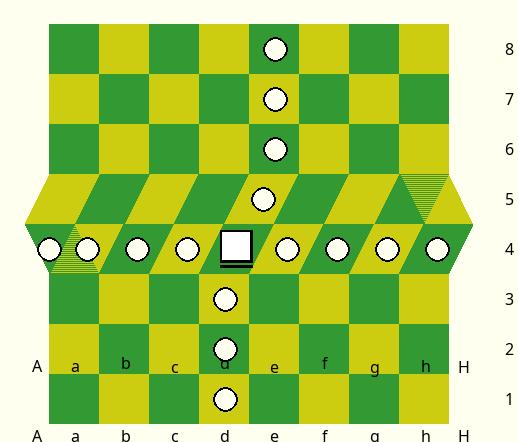
Each pair of overlapping spaces is known as a Switch. These two spaces share a side at one end, which they share with the same adjacent space. A4 and a4 both share a side with a3, and h5 and H5 both share a side with h6. So, from a1, a2, or a3, vertical movement is possible to either A4 or a4, and from there it may continue down either vertical column of laterally connected spaces. To illustrate, here is a movement diagram showing how the White Rook on a1 can move.

However, once the Rook is in the Switch, it no longer has the option of moving along either column. It can move vertically only in the column of laterally connected spaces it find itself in. To illustrate, this diagram shows where a Rook may move from a4.
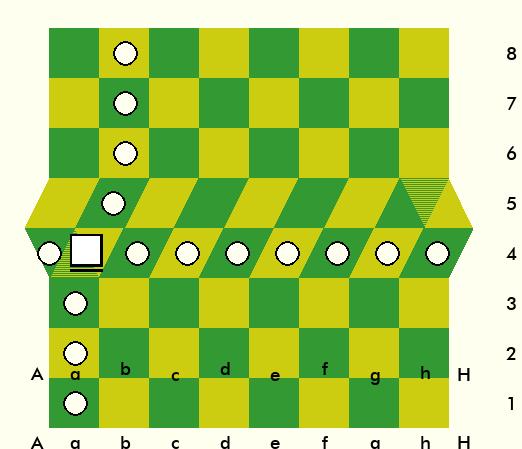
Likewise, if a Rook is in one of the branches of a Switch, it can move vertically only along the column of laterally connected spaces it finds itself in. This is illustrated by this diagram for the Rook on a6:
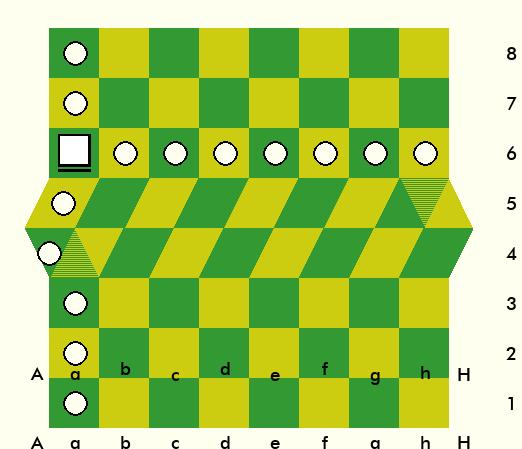
Bishop
On the Chess board, diagonal movement always changes the algebraic rank and file in a uniform manner. But because of the shifting over of some spaces, it doesn't always work out that way in this game. For this game, diagonal movement is understood as movement between spaces that share a corner but no sides, and diagonal movement in the same direction continues through opposite corners of spaces. In this diagram for a Bishop on d4, note that it is legal for it to move to d5, because d4 and d5 are diagonally connected.
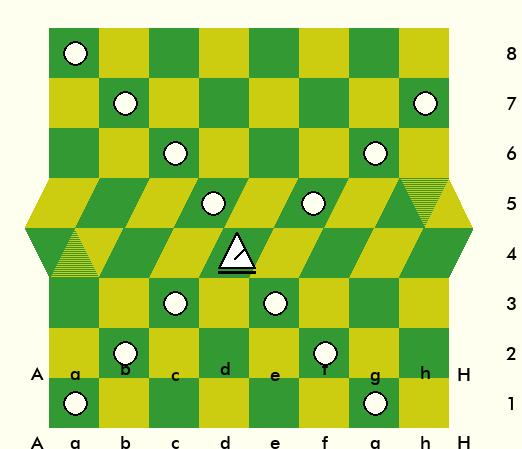
While diagonal movement in Chess is always colorbound, diagonal movement on the Route66 board can change color. From either A4 or H5, a Bishop has one path away on each color. So, by moving to A4 or H5 on one turn and moving away on another, a Bishop may change the color of the spaces it moves on. This can be seen in this diagram for a Bishop on A4:

Note that from a4 and h5, a Bishop can move away on only one color. The two new spaces, A4 and H5, are the only spaces on the board that connect diagonally to a space of each color. This thanks to the corner that A4 shares with a4 and the corner that H5 shares with h5. Because of this shared corner, a4 and A4 are each diagonally connected to b3, and h5 and H5 are each diagonally connected to g6. As this diagram shows, a Bishop on d1 can move to either a4 or A4. From this same position, it can also move to H5, though it cannot move to h5, because it connects to H5 through a corner it does not share with h5.
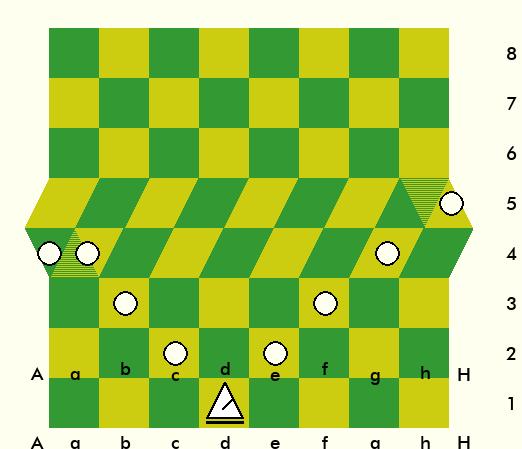
Queen
A Queen may move as either a Rook or a Bishop. All the examples already given for Rook and Bishop movement also apply to the Queen.
Knight
A Knight may leap directly to any non-adjacent space that may be reached by the combination of a single one-space lateral move and a single one-space diagonal move. While this will give you its usual L-shaped leaps on the Chess board, it does not always work out this way on the Reroute66 board. In the diagram below, you may note that the diagram looks familiar. All the spaces the Knight on d4 can leap to are on another color, and each one appears to be two ranks and one file or two files and one rank away. However, if you examine the coordinates, you will see that its legal moves from d4 include d6, which is in the same algebraic file.
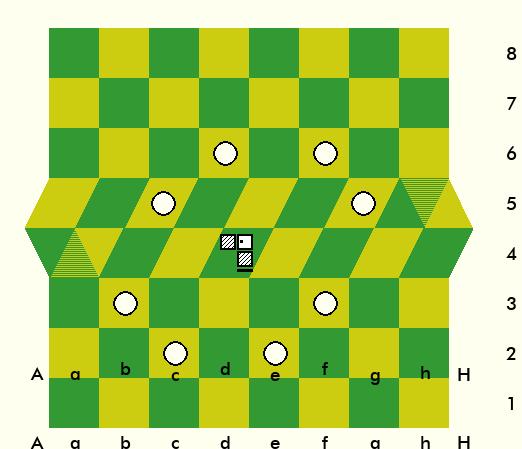
While a Knight normally moves to a space of a different color, it can on A4 or H5 move to a space of the same color. This is basically for the same reason that a Bishop on one of these spaces can move to spaces of a different color.
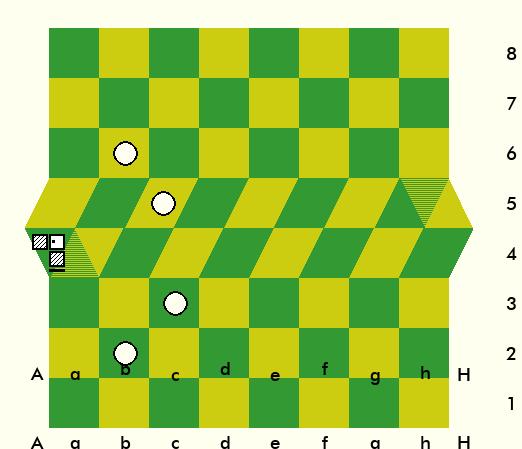
 This 'user submitted' page is a collaboration between the posting user and the Chess Variant Pages. Registered contributors to the Chess Variant Pages have the ability to post their own works, subject to review and editing by the Chess Variant Pages Editorial Staff.
This 'user submitted' page is a collaboration between the posting user and the Chess Variant Pages. Registered contributors to the Chess Variant Pages have the ability to post their own works, subject to review and editing by the Chess Variant Pages Editorial Staff.
By Fergus Duniho.
Last revised by Fergus Duniho.
Web page created: 2022-11-14. Web page last updated: 2022-11-14